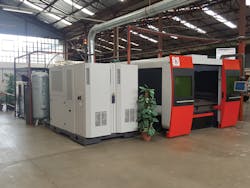The Republic of Zimbabwe, landlocked in southern Africa and previously known as Southern Rhodesia (1898), Rhodesia (1965), and Zimbabwe Rhodesia (1979), became a physical entity in 1980. The country’s economy is mixed with a dominating public sector. It used to have one of the strongest economies in Africa—however, political instability at the administrative level has led to negative GDP growth. Economic growth in 2017 was an estimated 2.6% in 2017 driven by strong performance in agriculture, mining, electricity, and water. Economic growth in 2018 (a projected 1%) was likely to be 1.2% in 2019—continuing to face a challenging political environment.
So, what ties Zimbabwe to Industrial Laser Solutions, lasers, and new technology? Maybe it’s the above comment about the country’s prior position as the economic leader in Africa. Did all the bright entrepreneurs flee the country over the ensuing years? I wrote several years ago that Africa might be the next industrial growth area, surpassing Asia. It was amusing to speculate on this and consequently, I started referring to the few ILS readers in Zimbabwe as the anointed who would pass on the knowledge gained from the magazine to the rest of Africa. It was a light-hearted attempt at some humor, tinged with my belief that Africa may be the next fast-growing industrial market for lasers.
I’d like to think Ralph and Greg Stead got the idea about laser cutting from ILS, but I doubt it because they are not on the magazine’s circulation list. But here’s their story.
Sawpower Blades (Pvt) Ltd, a family-owned business located in Msasa, Harare, Zimbabwe, has been in existence under that name for more than 23 years. The business was originally purchased as a struggling concern and was resurrected and restructured by Ralph Stead, who still plays a major key role in the day-to-day operations. His son, Greg Stead, joined the business about 16 years ago after completing his apprenticeship and further technical studies abroad.
First Cut (Johannesburg, South Africa; www.firstcut.co.za) has been Sawpower’s preferred saw blade suppliers for 22 years and it has a valuable relationship with them. The company grew its business from cutting consumables into supplying and supporting capital equipment, thus products and with this its affiliation to Bystronic (www.bystronic.com).
Ralph and Greg both come from a manufacturing background. Unfortunately, due to the nature and decline of the Zimbabwean economy, the country has become largely dependent on imports, which depletes foreign currency reserves. This has been the same for Sawpower. Although it manufactures its own range of saw blades in-house, the rest of the business relies on such imports.
They had been looking at getting back into manufacturing about six years ago, but circumstances at the time made it fairly prohibitive. In 2016, together with First Cut and Bystronic, Ralph and Greg started learning and understanding more about fiber laser technology, and at the end of 2017, they signed a deal with them to install the first-ever fiber laser machine in Zimbabwe.
Being able to supply a value-added process to raw materials and bring the latest technology in sheet metal processing means it is now able to offer these in Zimbabwe instead of importing them. Additionally,
Sawpower now represents Bystronic in Zimbabwe and this machine also serves as a working showroom. They have already taken on import substitution work as well as work for the mines and farming industries. Import enquires have been received and they hope to pursue this vigorously in 2019.
Greg says the installation, commissioning, and running of the Bystronic BySprint Fiber 3015 was, and continues to be, an exciting project (FIGURE). The all-around support received from Bystronic and First Cut has been exceptional, as those companies are passionate and dedicated to their products. Together with the BySprint Fiber 3015 laser, Sawpower also runs a NitraCut nitrogen generator, which it uses to generate its own nitrogen assist gas.
According to Greg, the company chose to use Bystronic’s BySoft programming software. He says this is a powerful programming tool that works in harmony with the laser and all future manufacturing processes. It also means that the company is dealing with one supplier when it comes to technical support. Whether it be a minor programming or nesting enquiry right up to major service work or technical support on the machine, Bystronic and First Cut have everything covered.
As this is being written, the economic and social news for Zimbabwe is, as the pundits say, fluid. So, I’ll be paying more attention to that country, especially pulling for Greg and Sawpower.

David Belforte | Contributing Editor
David Belforte (1932-2023) was an internationally recognized authority on industrial laser materials processing and had been actively involved in this technology for more than 50 years. His consulting business, Belforte Associates, served clients interested in advanced manufacturing applications. David held degrees in Chemistry and Production Technology from Northeastern University (Boston, MA). As a researcher, he conducted basic studies in material synthesis for high-temperature applications and held increasingly important positions with companies involved with high-technology materials processing. He co-founded a company that introduced several firsts in advanced welding technology and equipment. David's career in lasers started with the commercialization of the first industrial solid-state laser and a compact CO2 laser for sheet-metal cutting. For several years, he led the development of very high power CO2 lasers for welding and surface treating applications. In addition to consulting, David was the Founder and Editor-in-Chief of Industrial Laser Solutions magazine (1986-2022) and contributed to other laser publications, including Laser Focus World. He retired from Laser Focus World in late June 2022.
